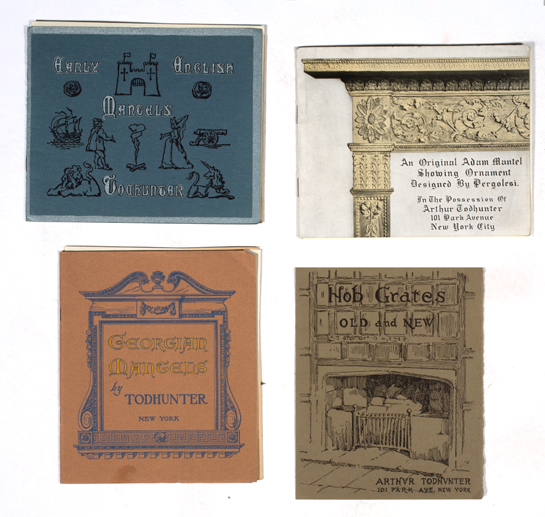01a. Miscellaneous Mantels
Clockwise from top right:
“An Original Adam Mantel Showing Ornament Designed By Pergolesi.” Arthur Todhunter; New York, NY; c.1917.
“Hob Grates Old and New.” Arthur Todhunter; New York, NY; c.1910-1925.
“Georgian Mantels by Todhunter.” Arthur Todhunter; New York, NY; c.1910-1925.
“Early English Mantels.” Arthur Todhunter; New York, NY; c.1910-1925.
Fireplaces and mantels harken back to one of humankind’s earliest and most indispensible rituals: the fire gathering. Moving indoors, it evolved into the hearths of medieval Europe, and then the masonry chimneys of the Renaissance, where, for the first time, the fireplace and its attendant ornamentation “became the focal point of the room, both aesthetically and socially.”18
Though the increased functionality, smaller size and lower price of stoves eventually replaced fireplaces in many homes, they have nonetheless endured, perhaps because the fireplace “is a pleasure not made up by any invention whatever.”19
Georges-Joseph Demotte was an antique dealer based in Paris known for the sale of medieval sculpture and architectural fragments.
18. Henry J. Kauffman, The American Fireplace: Chimneys, Mantelpieces, Fireplaces & Accessories. (Nashville : T. Nelson, [1972]), 11. ↩
19. Lewis F. Allen, Rural Architecture. (New York : Saxton, 1852).↩
"Tools of the Trade: 19th- and 20th-Century Architectural Trade Catalogs," Case 5, Ryerson & Burnham Libraries, August 4, 2015-October 12, 2015.
Link to R&B Archives Digital Collections record
Link to R&B Archives Digital Collections record
Link to R&B Archives Digital Collections record
Link to R&B Archives Digital Collections record

